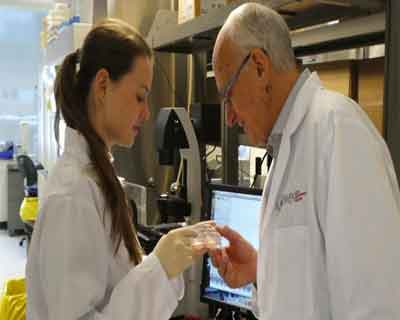- Home
- Editorial
- News
- Practice Guidelines
- Anesthesiology Guidelines
- Cancer Guidelines
- Cardiac Sciences Guidelines
- Critical Care Guidelines
- Dentistry Guidelines
- Dermatology Guidelines
- Diabetes and Endo Guidelines
- Diagnostics Guidelines
- ENT Guidelines
- Featured Practice Guidelines
- Gastroenterology Guidelines
- Geriatrics Guidelines
- Medicine Guidelines
- Nephrology Guidelines
- Neurosciences Guidelines
- Obs and Gynae Guidelines
- Ophthalmology Guidelines
- Orthopaedics Guidelines
- Paediatrics Guidelines
- Psychiatry Guidelines
- Pulmonology Guidelines
- Radiology Guidelines
- Surgery Guidelines
- Urology Guidelines
Scientists produce first biological pacemaker

Scientists from the McEwen Centre for Regenerative Medicine, University Health Network, have developed the first functional pacemaker cells from human stem cells, paving the way for alternate, biological pacemaker therapy.
Their findings, "Sinoatrial node cardiomyocytes derived from human pluripotent cells function as a biological pacemaker," published online in Nature Biotechnology on Dec. 12, detail how human pluripotent stem cells can be coaxed in 21 days to develop into pacemaker cells, which regulate heart beats with electrical impulses. These human pacemaker cells were tested in rat hearts and were shown to function as a biological pacemaker, by activating the electrical impulses that trigger the contraction of the heart.
Pluripotent stem cells have the potential to differentiate into more than 200 different cell types that make up every tissue and organ in the body.
Sinoatrial node pacemaker cells are the heart's primary pacemaker, controlling the heartbeat throughout life. Defects in the pacemaker can lead to heart rhythm disorders that are commonly treated by implantation of electronic pacemaker devices. Learning how to generate pacemaker cells could help in understanding disorders in pacemaker cells, and provide a cell source for developing a biological pacemaker. Biological pacemakers represent a promising alternative to electronic pacemakers, overcoming such drawbacks as a lack of hormonal responsiveness and the inability to adapt to changes in heart size in pediatric patients.
The researchers used a developmental-biology approach to establish a specific protocol for generating the pacemaker cells.
"What we are doing is human biology in a petri dish," says Dr. Gordon Keller, Director of the McEwen Centre, the senior author, and a trailblazer in generating a wide variety of specialized cells from human stem cells. "We are replicating nature's way of making the pacemaker cell."
Based on previous findings in animal models, the researchers at the McEwen Centre tested and mapped out the specific developmental pathway of how human pluripotent stem cells become pacemaker cells. This was achieved by testing different signaling molecules at different times throughout the 21 days to guide the cells towards their goal.
"It's tricky," says Dr. Stephanie Protze, a post-doctoral fellow in the laboratory of Dr. Keller and the first author in the Nature paper. "You have to determine the right signaling molecules, at the right concentration, at the right time to stimulate the stem cells."
Adds Dr. Keller, who is also a Professor in the Department of Medical Biophysics at the University of Toronto: "We understand the importance of precision in developmental biology in setting out the process by which organisms grow and develop. We use that same precision in the petri dish because we are replicating these same processes."
Once the team established which signaling pathways are activated at different stages to generate the pacemaker cells, they demonstrated that the new pacemaker cells could initiate and regulate the heartbeat in rats.
The researchers noted that human clinical trials to test such biological pacemakers are from five to 10 years away, and that the next step is to launch safety and reliability pre-clinical trials on the pacemaker cells.
Meanwhile, researchers can use their new technology to make pacemaker cells from patients suffering from pacemaker dysfunction. They can then use these patient-specific cells to study the "disease in a (petri) dish" and to identify new drugs that will improve their pacemaker function.
Long term, the team hopes to develop a biological pacemaker to transplant into patients who need an electronic one. More than 10,000 electric pacemakers are implanted annually in Canada, with more than 120,000 patients living with them. They can last anywhere from five to 10 years or more -- on the average about seven years. If successful, the biological pacemaker holds the promise of a lifelong cure.

Disclaimer: This site is primarily intended for healthcare professionals. Any content/information on this website does not replace the advice of medical and/or health professionals and should not be construed as medical/diagnostic advice/endorsement or prescription. Use of this site is subject to our terms of use, privacy policy, advertisement policy. © 2020 Minerva Medical Treatment Pvt Ltd